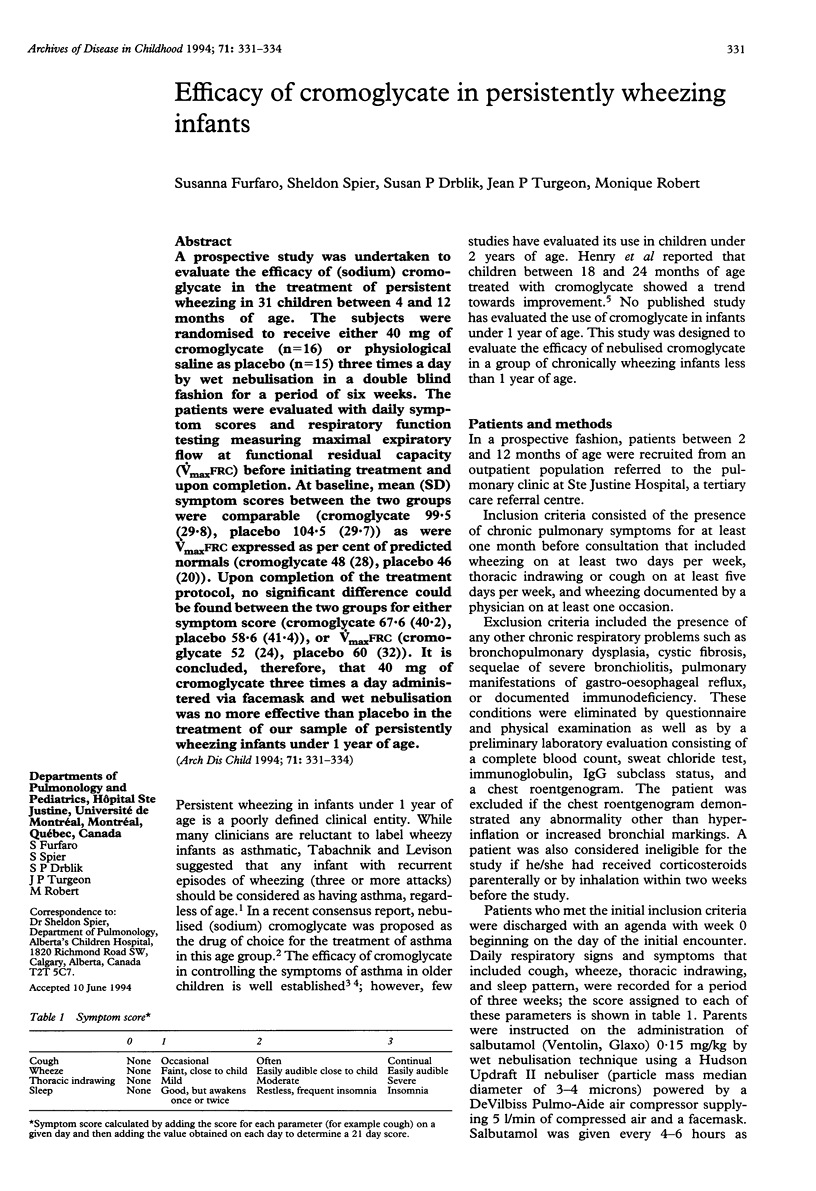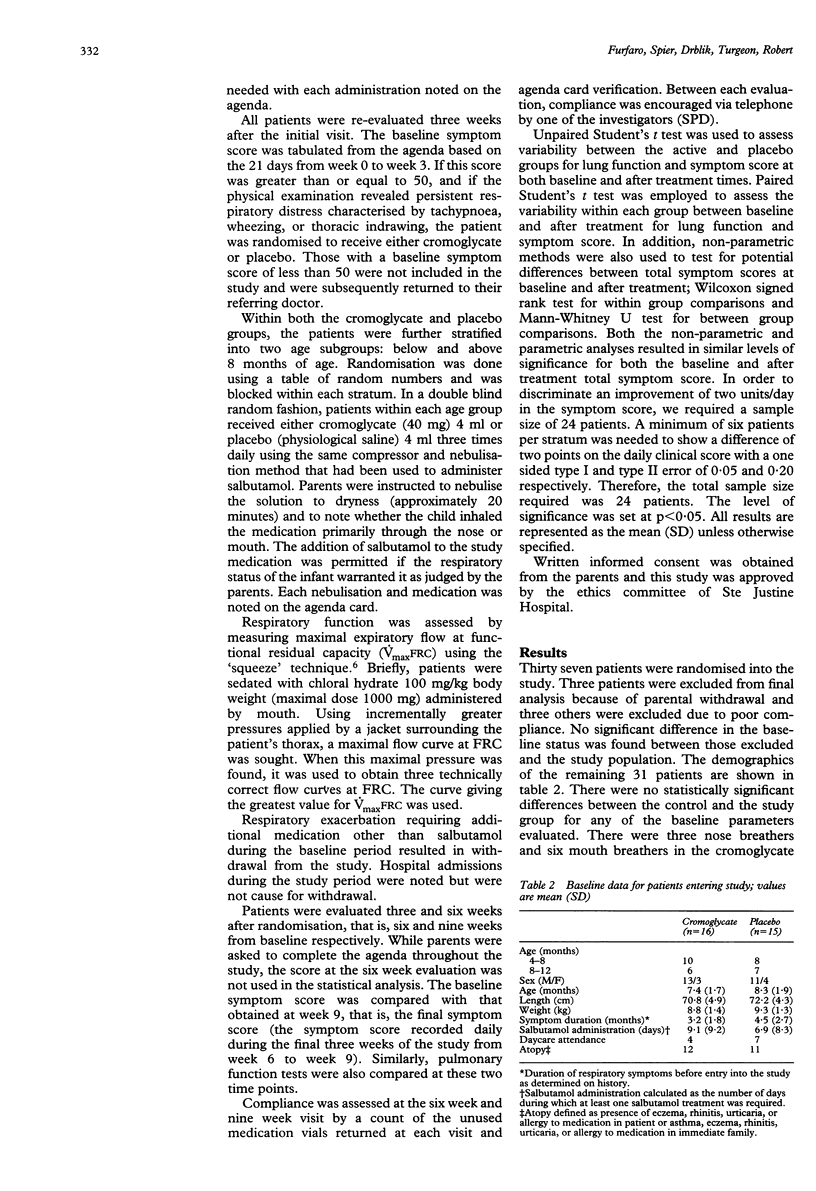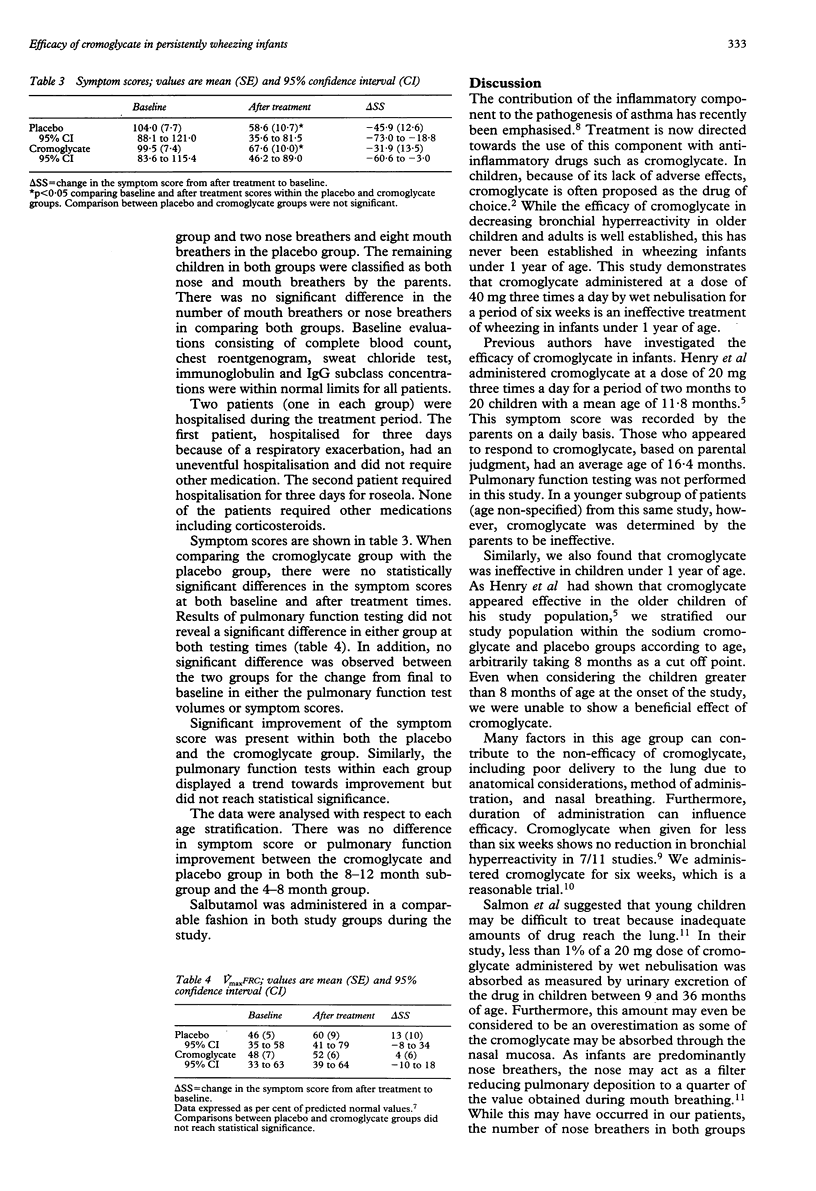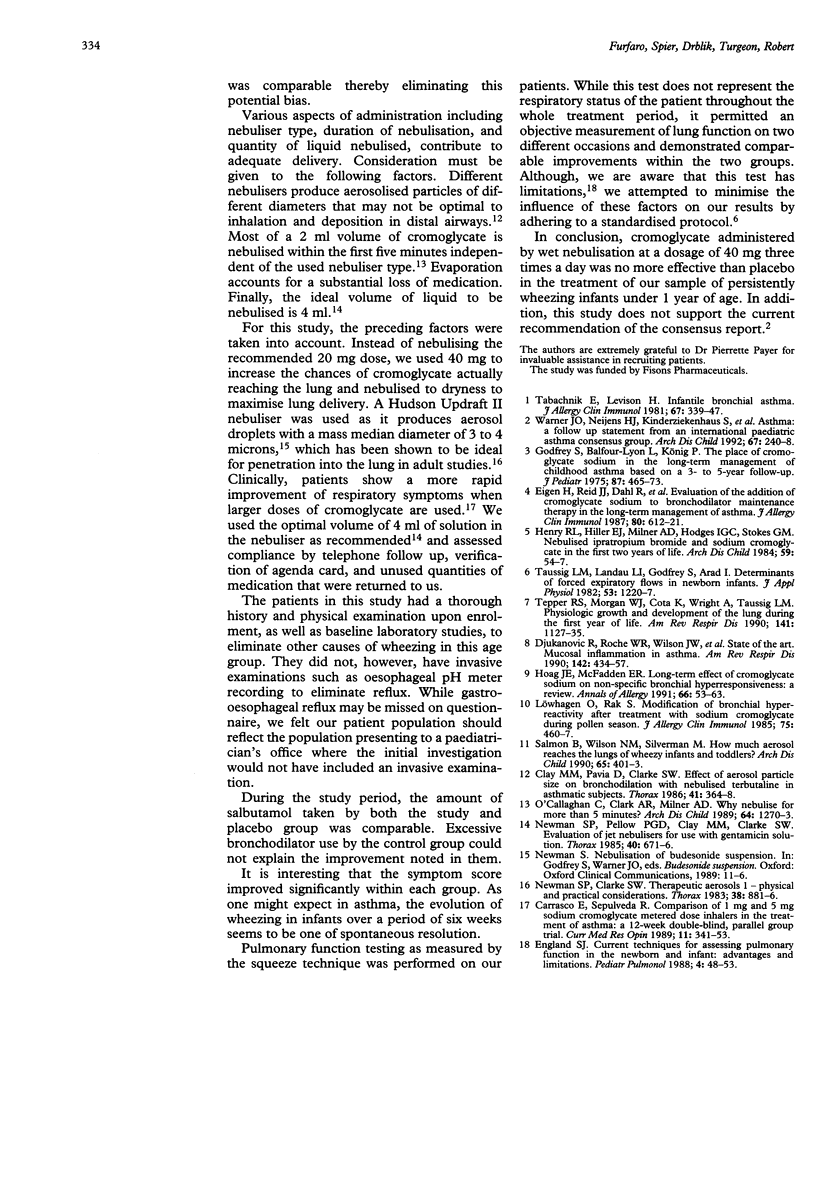Abstract
A prospective study was undertaken to evaluate the efficacy of (sodium) cromoglycate in the treatment of persistent wheezing in 31 children between 4 and 12 months of age. The subjects were randomised to receive either 40 mg of cromoglycate (n = 16) or physiological saline as placebo (n = 15) three times a day by wet nebulisation in a double blind fashion for a period of six weeks. The patients were evaluated with daily symptom scores and respiratory function testing measuring maximal expiratory flow at functional residual capacity (VmaxFRC) before initiating treatment and upon completion. At baseline, mean (SD) symptom scores between the two groups were comparable (cromoglycate 99.5 (29.8), placebo 104.5 (29.7)) as were VmaxFRC expressed as per cent of predicted normals (cromoglycate 48 (28), placebo 46 (20)). Upon completion of the treatment protocol, no significant difference could be found between the two groups for either symptom score (cromoglycate 67.6 (40.2), placebo 58.6 (41.4)), or VmaxFRC (cromoglycate 52 (24), placebo 60 (32)). It is concluded, therefore, that 40 mg of cromoglycate three times a day administered via facemask and wet nebulisation was no more effective than placebo in the treatment of our sample of persistently wheezing infants under 1 year of age.
Full text
PDF



Selected References
These references are in PubMed. This may not be the complete list of references from this article.
- Asthma: a follow up statement from an international paediatric asthma consensus group. Arch Dis Child. 1992 Feb;67(2):240–248. doi: 10.1136/adc.67.2.240. [DOI] [PMC free article] [PubMed] [Google Scholar]
- Carrasco E., Sepulveda R. Comparison of 1 mg and 5 mg sodium cromoglycate metered dose inhalers in the treatment of asthma: a 12-week double-blind, parallel group trial. Curr Med Res Opin. 1989;11(6):341–353. doi: 10.1185/03007998909110134. [DOI] [PubMed] [Google Scholar]
- Clay M. M., Pavia D., Clarke S. W. Effect of aerosol particle size on bronchodilatation with nebulised terbutaline in asthmatic subjects. Thorax. 1986 May;41(5):364–368. doi: 10.1136/thx.41.5.364. [DOI] [PMC free article] [PubMed] [Google Scholar]
- Djukanović R., Roche W. R., Wilson J. W., Beasley C. R., Twentyman O. P., Howarth R. H., Holgate S. T. Mucosal inflammation in asthma. Am Rev Respir Dis. 1990 Aug;142(2):434–457. doi: 10.1164/ajrccm/142.2.434. [DOI] [PubMed] [Google Scholar]
- Eigen H., Reid J. J., Dahl R., Del Bufalo C., Fasano L., Gunella G., Sahlstrom K. K., Alanko K. L., Greenbaum J., Hagelund C. H. Evaluation of the addition of cromolyn sodium to bronchodilator maintenance therapy in the long-term management of asthma. J Allergy Clin Immunol. 1987 Oct;80(4):612–621. doi: 10.1016/0091-6749(87)90016-9. [DOI] [PubMed] [Google Scholar]
- England S. J. Current techniques for assessing pulmonary function in the newborn and infant: advantages and limitations. Pediatr Pulmonol. 1988 Jan-Feb;4(1):48–53. doi: 10.1002/ppul.1950040110. [DOI] [PubMed] [Google Scholar]
- Godfrey S., Balfour-Lynn L., König P. The place of cromolyn sodium in the long-term management of childhood asthma based on a 3- to 5-year follow-up. J Pediatr. 1975 Sep;87(3):465–473. doi: 10.1016/s0022-3476(75)80663-9. [DOI] [PubMed] [Google Scholar]
- Hanrahan J. P., Tager I. B., Castile R. G., Segal M. R., Weiss S. T., Speizer F. E. Pulmonary function measures in healthy infants. Variability and size correction. Am Rev Respir Dis. 1990 May;141(5 Pt 1):1127–1135. doi: 10.1164/ajrccm/141.5_Pt_1.1127. [DOI] [PubMed] [Google Scholar]
- Henry R. L., Hiller E. J., Milner A. D., Hodges I. G., Stokes G. M. Nebulised ipratropium bromide and sodium cromoglycate in the first two years of life. Arch Dis Child. 1984 Jan;59(1):54–57. doi: 10.1136/adc.59.1.54. [DOI] [PMC free article] [PubMed] [Google Scholar]
- Hoag J. E., McFadden E. R., Jr Long-term effect of cromolyn sodium on nonspecific bronchial hyperresponsiveness: a review. Ann Allergy. 1991 Jan;66(1):53–63. [PubMed] [Google Scholar]
- Löwhagen O., Rak S. Modification of bronchial hyperreactivity after treatment with sodium cromoglycate during pollen season. J Allergy Clin Immunol. 1985 Apr;75(4):460–467. doi: 10.1016/s0091-6749(85)80018-x. [DOI] [PubMed] [Google Scholar]
- Newman S. P., Clarke S. W. Therapeutic aerosols 1--physical and practical considerations. Thorax. 1983 Dec;38(12):881–886. doi: 10.1136/thx.38.12.881. [DOI] [PMC free article] [PubMed] [Google Scholar]
- Newman S. P., Pellow P. G., Clay M. M., Clarke S. W. Evaluation of jet nebulisers for use with gentamicin solution. Thorax. 1985 Sep;40(9):671–676. doi: 10.1136/thx.40.9.671. [DOI] [PMC free article] [PubMed] [Google Scholar]
- O'Callaghan C., Clark A. R., Milner A. D. Why nebulise for more than five minutes? Arch Dis Child. 1989 Sep;64(9):1270–1273. doi: 10.1136/adc.64.9.1270. [DOI] [PMC free article] [PubMed] [Google Scholar]
- Salmon B., Wilson N. M., Silverman M. How much aerosol reaches the lungs of wheezy infants and toddlers? Arch Dis Child. 1990 Apr;65(4):401–403. doi: 10.1136/adc.65.4.401. [DOI] [PMC free article] [PubMed] [Google Scholar]
- Tabachnik E., Levison H. Postgraduate course presentation. Infantile bronchial asthma. J Allergy Clin Immunol. 1981 May;67(5):339–347. doi: 10.1016/0091-6749(81)90077-4. [DOI] [PubMed] [Google Scholar]
- Taussig L. M., Landau L. I., Godfrey S., Arad I. Determinants of forced expiratory flows in newborn infants. J Appl Physiol Respir Environ Exerc Physiol. 1982 Nov;53(5):1220–1227. doi: 10.1152/jappl.1982.53.5.1220. [DOI] [PubMed] [Google Scholar]


